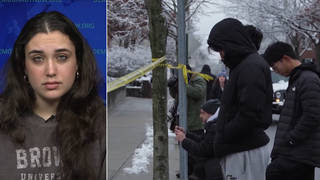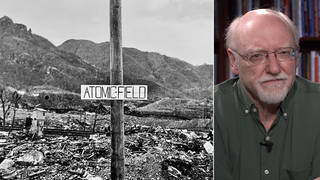
Topics
Guests
- Harvey Wassermanindependent journalist and longtime anti-nuclear activist. In the early 1970s, he helped found the grassroots movement against nuclear power in the United States. He is senior editor of the Ohio-based freepress.org and the editor of nukefree.org.
Thirty years ago this Saturday, the Three Mile Island nuclear reactor at Harrisburg, Pennsylvania malfunctioned, sparking a meltdown that resulted in the release of radioactivity. It was the worst nuclear accident in US history. The accident at Three Mile Island fueled the nuclear debate in this country that continues to rage to this day. We speak with anti-nuclear activist Harvey Wasserman. [includes rush transcript]
Transcript
JUAN GONZALEZ: Thirty years ago this Saturday, the Three Mile Island nuclear reactor at Harrisburg, Pennsylvania malfunctioned, sparking a meltdown that resulted in the release of radioactivity. It was the worst nuclear accident in US history.
In the pre-dawn hours of March 28, 1979, the cooling system of Three Mile Island’s Unit Two reactor malfunctioned, causing temperatures inside to skyrocket. Without water to cool them, more than half of the reactor’s 36,000 nuclear fuel rods ruptured.
Lieutenant Governor William Scranton first appeared on local TV and told residents there was no need to evacuate but advised all citizens within ten miles of the plant to stay indoors with their windows closed. Pennsylvania Governor Richard Thornburgh then evacuated pregnant women and small children living within five miles of the plant. Some estimate that well over 100,000 people fled Harrisburg and the surrounding areas.
The evening of March 28th, 1979, famed news anchor Walter Cronkite opened his nightly newscast on CBS by calling the disaster, quote, “the first step in a nuclear nightmare.” For the next four days, the nation and the world feared a full-scale meltdown would follow. This is an excerpt of Cronkite’s broadcast on March 30th.
WALTER CRONKITE: Good evening. The world has never known a day quite like today. It faced the considerable uncertainties and dangers of the worst nuclear power plant accident of the Atomic Age. And the horror tonight is that it could get much worse. It is not an atomic explosion that is feared; the experts say that is impossible. But the specter was raised that perhaps the next most serious kind of nuclear catastrophe: a massive release of radioactivity. The Nuclear Regulatory Commission cited that possibility with an announcement that, while it is not likely, the potential is there for the ultimate risk of a meltdown at the Three Mile Island atomic power plant outside Harrisburg, Pennsylvania.
AMY GOODMAN: The accident at Three Mile Island fueled the nuclear debate in this country that continues to rage to this day.
We’re joined now by Democracy Now! video stream by anti-nuclear activist and editor of nukefree.org, Harvey Wasserman.
Harvey, welcome to Democracy Now! On this eve of the thirtieth anniversary of Three Mile Island, what do you think it’s most important for people to understand? There are some people listening right now who weren’t even born in 1979.
HARVEY WASSERMAN: What’s important to understand is that people were killed in this accident. The nuclear industry continues to spread the lie that no one was harmed. In fact, nobody knows how much radiation escaped from Three Mile Island. Nobody knows where it went. And nobody knows what the impact was.
I went into the central Pennsylvania area a year after the accident, and I conducted dozens of interviews with people who were clearly harmed by the radiation from the accident. There were cancers, leukemias, birth defects, stillbirths, hair loss, unexplained lesions, rashes. It was like being in the middle of a post-Hiroshima nightmare.
And the reality is that the nuclear industry continues to deny that anyone was harmed, and all the serious indicators show that, in fact, people were harmed. There’s a 2,400-person — or —family, rather -— class-action lawsuit that was filed in the 1980s that’s still pending. The federal court system will not allow the people of central Pennsylvania to have an official hearing on the health impacts of this accident. And yet, the industry, which wants to build new reactors, continues to spread the lie that no one was killed at Three Mile Island. It’s utterly false.
JUAN GONZALEZ: Harvey, I was a young reporter, actually, at the Philadelphia Daily News in 1979 when the accident occurred, and I remember vividly the debates in the newsroom among the reporters as to whether they would want to go and cover it, because they had to travel to Three Mile Island, which was about a couple of hours’ drive away. And the thing that struck me most was the lesson I learned — the greatest lesson I learned is that in major accidents and crises like this, you cannot depend on government officials to tell you the truth, because they kept changing the story, day after day, as to the nature of the release. And as you say, there’s still not a clear sense of what the extent of the release was. What has been the continuing health effects on the communities closest to the accident, as far as you can tell?
HARVEY WASSERMAN: Well, in fact, there’s just been two new studies released in Harrisburg this week. One indicates that as much as a hundred times more radiation escaped than the government and the industry have been willing to admit. And the other is that the statistics clearly show ongoing problems of cancer, leukemia, other radiation-related diseases. The fact of the matter is that the country — this is the best-known, the most infamous industrial accident in US history, and yet the industry and the government refuse to get to the bottom of the situation.
You should count yourself lucky that you didn’t go there. Many journalists who did go to central Pennsylvania suffered significant harm. The radiation releases were very, very significant. And, in fact, Walter Cronkite was wrong. The experts said there was no possibility of an explosion; there was a possibility of an explosion, because there was a hydrogen bubble inside the reactor.
So, the accident at Three Mile Island is ongoing. We will never have closure until the people who sued, the central Pennsylvanians, the 2,400 families, get a day in court. The federal courts still say that not enough radiation was released to cause any harm, but they don’t know how much radiation was released. In fact, the Nuclear Regulatory Commission has admitted they don’t know how much radiation was released. And they certainly don’t know where it went. And every indication is that the health damage was significant and that people were killed at Three Mile Island.
AMY GOODMAN: Harvey Wasserman, we last had you on on — I’m looking at our website — February 5th, 2009. We had you on to talk about the coalition of environmental groups that were calling on senators to remove a controversial provision from the $900 billion stimulus bill that could lead to the construction of a new generation of nuclear power plants. That actually was taken out. What happened?
HARVEY WASSERMAN: We won that three separate times. Three times the industry has come in demanding a $50 billion advance bailout, a blank check from the taxpayers to fund new nuclear plants, and we beat them with the help of Nancy Pelosi and Harry Reid three times.
But there are still $18.5 billion left over from the Bush administration, and the industry — to do loan guarantees, and the industry is going to come in again and again. After all these years, the nuclear power industry cannot get private financing for to build new nuclear plants. They cannot get private insurance to guarantee against an accident like Three Mile Island. And now that the Yucca Mountain waste dump has essentially been canceled, there — after a half-century, there is no place for the high-level nuclear radioactive waste to go from nuclear power plants. It’s a catastrophe. And yet this industry continues to push itself and to claim a nuclear renaissance.
What they’re now doing is they’ve gone into states like Florida, Georgia and the Carolinas demanding that rate payers pay for new reactors before they’re even built. And, you know, so this is an ongoing struggle. And at the heart of it is what happened at Three Mile Island and the continued denial of this industry of what really happened, which is massive radiation releases and death and other harm to people in the area and, of course, to the local animals.
AMY GOODMAN: Harvey Wasserman, what does President Obama’s support for nuclear power actually mean? And also, you mentioned Georgia. The Georgia Public Service Commission approved earlier this month two additional nuclear reactors for Georgia power, which — is this the first time nuclear power plants will be built in some thirty years?
HARVEY WASSERMAN: Yes. And, well, we think we’re going to stop them. As I said, we’ve stopped the $50 billion.
I want to mention that the reactor containment at Three Mile Island was actually thicker than most others, because citizen action, prior to the construction of the plant, demanded a thicker containment, because the Three Mile Island Unit 2 is right in the flight path of the Harrisburg Airport. Had that not happened, we might well have had an explosion at Three Mile Island. And today, we are continuing to fight these new reactors. I think, ultimately, we can stop them. But it requires full information to the general public. People have to know what really happened at Three Mile Island and have to understand that we have stopped the nuclear industry significantly over the past thirty or forty years of activism.
In 1974, Richard Nixon said there’d be a thousand nuclear plants in the year 2000, and we’ve kept it under 120 — way too many still. There are 104 reactors now operating in the United States, but every one of them could be melting as we do this interview. And there’s absolutely no place in the future for nuclear power. The Obama administration has got to come to its senses and stop this discussion of building new reactors, because it makes no sense.
AMY GOODMAN: Harvey Wasserman, thank you very much for joining us. He’s with freepress.org, not to be confused with Bob McChesney’s freepress.net. Special thanks to the documentary Containment: Life After Three Mile Island. We also want to thank the filmmakers of Black Wave: The Legacy of the Exxon Valdez in our coverage this week of the twentieth anniversary of the Exxon Valdez oil spill. And you can go to our website for more information. You can also go to blackwavethefilm.com.













Media Options